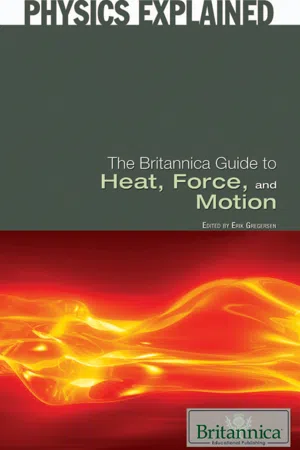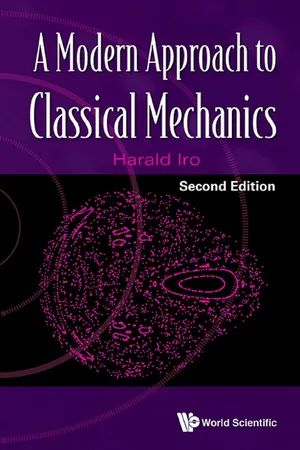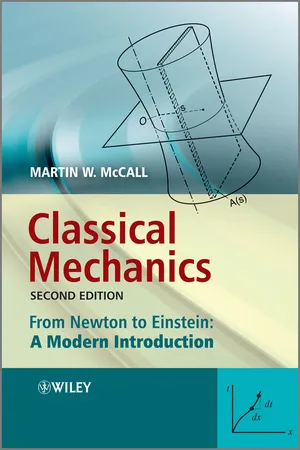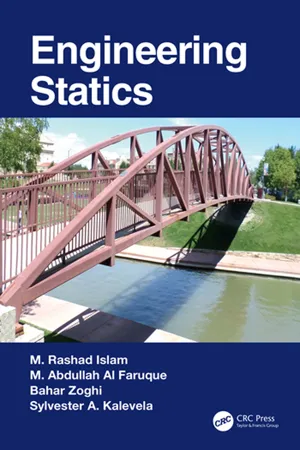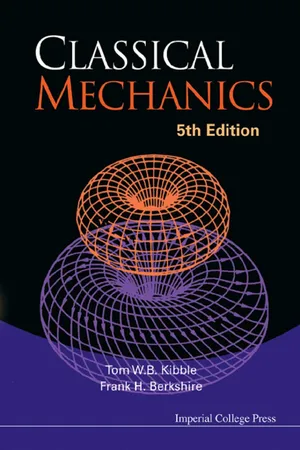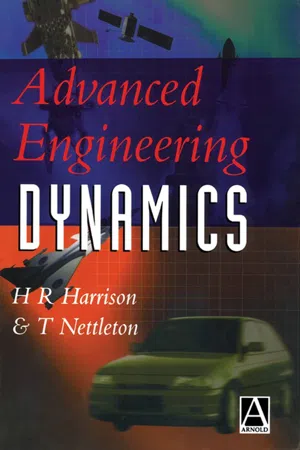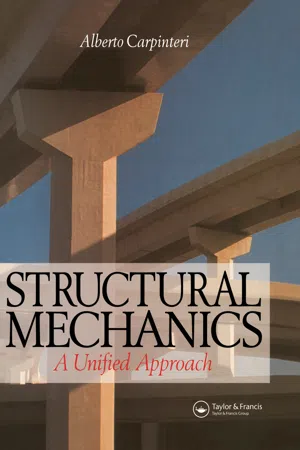Mathematics
Rigid Bodies in Equilibrium
Rigid bodies in equilibrium refer to objects that are not deforming or moving. In this state, the sum of all forces and torques acting on the body is zero, and the body remains at rest or moves with constant velocity. This concept is important in physics and engineering for analyzing the stability and balance of structures and mechanical systems.
Written by Perlego with AI-assistance
Related key terms
10 Key excerpts on "Rigid Bodies in Equilibrium"
- eBook - ePub
- Britannica Educational Publishing, Erik Gregersen(Authors)
- 2010(Publication Date)
- Britannica Educational Publishing(Publisher)
CHAPTER 5 RIGID BODIEST he previous chapter discussed mechanics in terms of particles. However, many objects are not particles but what physicists call rigid bodies. A body is formally regarded as rigid if the distance between any set of two points in it is always constant. In reality no body is perfectly rigid. When equal and opposite forces are applied to a body, it is always deformed slightly. The body’s own tendency to restore the deformation has the effect of applying counterforces to whatever is applying the forces, thus obeying Newton’s third law. Calling a body rigid means that the changes in the dimensions of the body are small enough to be neglected, even though the force produced by the deformation may not be neglected.STATICS
Statics is the study of bodies and structures that are in equilibrium. For a body to be in equilibrium, there must be no net force acting on it. In addition, there must be no net torque acting on it.When a body has a net force and a net torque acting on it owing to a combination of forces, all the forces acting on the body may be replaced by a single (imaginary) force called the resultant, which acts at a single point on the body, producing the same net force and the same net torque. The body can be brought into equilibrium by applying to it a real force at the same point, equal and opposite to the resultant. This force is called the equilibrant.(A) A body in equilibrium under equal and opposite forces. (B) A body not in equilibrium under equal and opposite forces . Copyright Encyclopædia Britannica; rendering for this edition by Rosen Educational ServicesThe resultant force ( F R ) produces the same net force and the same net torque about point A as F 1 + F 2 ; the body can be brought into equilibrium by applying the equilibrant forceFe - eBook - ePub
Analysis of Structures
An Introduction Including Numerical Methods
- Joe G. Eisley, Antony M. Waas(Authors)
- 2011(Publication Date)
- Wiley(Publisher)
2 Static Equilibrium 2.1 IntroductionWhile all solid bodies deform to some extent under loads these deformations are often so small that the bodies may be considered to be rigid for certain purposes. A rigid body is an idealization that considers a body to have no deformation when subject to loads. When all forces, both known applied forces and unknown restraint forces, are identified and we attempt to sum the forces and moments we can have two possible situations:1. The number of unknown forces is less than the number of independent equations of motion. Rigid body motion may result. This is the subject of rigid body dynamics . We shall not study this case here.2. The number of unknown forces is equal to or greater than the number of independent equations of motion. There is no rigid body motion and we have static equilibrium . There are two subcases:a. The body is statically determinate when the number of unknown forces is equal to the number of independent equations of static equilibrium. All the unknown forces can be determined by the summation of forces and moments without regard to what the body is made of or to its deformation.b. The body is statically indeterminate when the number of unknown forces is greater than the number of independent equations of static equilibrium. The summation of forces and moments is not sufficient to find the unknown forces. We need to consider the deformation of the body and the physical properties that contribute to resisting deformation.In the case of a statically indeterminate body we must introduce additional equations to obtain a solution. In this chapter we shall be interested primarily in statically determinate bodies. The subsequent chapters will contend with both statically determinate and statically indeterminate problems.2.2 Free Body DiagramsWe shall illustrate each subcase with a simple example in two dimensions using concentrated forces only. In these examples it is assumed that the applied forces initially are known and the restraint forces are unknown. - eBook - ePub
- Harald Iro(Author)
- 2015(Publication Date)
- WSPC(Publisher)
11The rigid body
In this chapter, we consider the mechanics of a rigid body. We imagine a rigid body as an ensemble of point masses that are fixed relative to each other by their mutual forces. This is the limiting case of the more realistic situation, in which the N point masses at positions rα, α = 1, …, N, interact only via two-particle interactions, so that the total potential is given by (cf. Eq. (10.48) ) Vαβ(rαβ), where rαβ= |rα− rβ|. The values rγ= aγ, γ = 1, …, N, for which all internal forces vanish,are the equilibrium positions aα. Whether such positions exist depends on the potential; we assume that equilibrium positions exist.Analogous to the procedure introduced in Section 3.2 for a onedimensional system, one can expand the potential about these positions. This will be investigated more closely in the next chapter. For a stable equilibrium, the positions aαmust be minima of the total potential. In particular, the eigenvalues of the matrix of coefficients in the Taylor expansion of V have to be positive. (Note that for fixed indices α and β, this is already a 9 × 9-matrix!) If the are very large1 , a large displacement from equilibrium requires more energy than supplied. If, for some energy range, each point mass practically2 stays in its equilibrium position, then this energy range is the rigid body region; only higher energies can lead to deformations of the body. In this chapter, we start off with some basics of statics. Our main concern, however, is the dynamics of rigid bodies.11.1 Degrees of freedom of a rigid body
In the ideal rigid body, the distances between any pair of the N point masses is fixed,Since rαβ= rβα, we have (N2 − N)/2 conditions. However, these conditions cannot all be independent, since for large enough N they would outnumber the 3N degrees of freedom. Furthermore, we know that the rigid body has are at most six degrees of freedom. How does this happen? We note that to fix the position of each particle relative to the others, it is not necessary to specify all the distances from each particle to every other particle. All we need is the following. First select three point masses that do not lie on a straight line. The positions of these three point masses, given as their nine coordinates, define a plane in space. Then a fourth point mass is uniquely fixed by its distances to the three point masses selected first3 . This applies also to the remaining point masses. Hence, all the point masses except the three selected first, are uniquely fixed by their distances to the three reference point masses, giving 3 × (N − 3) conditions for the N − 3 point masses. Thus, the number of degrees of freedom is reduced to 3N − 3 (N − 3) = 9. Indeed, the motion of the N − 3 particles follows immediately from the motion of the three reference particles. Finally, the degrees of freedom of the three reference particles – originally nine – are diminished by the three independent conditions of fixed distance between the reference particles. Therefore the total number of the degrees of freedom of a rigid body is six. This number is independent of N, and therefore also holds in the continuum limit N - eBook - ePub
- Michael M. Mansfield, Colm O'Sullivan(Authors)
- 2020(Publication Date)
- Wiley(Publisher)
7 Rigid body dynamicsAIMS
- To show how the principles governing the motion of many‐body systems, discussed in the previous chapter, can be applied to the motion of rigid bodies
- To develop a formalism for the treatment of the motion of a rigid body about a fixed axis
- To outline the formal equivalence between the principles which determine the motion of rigid bodies about a fixed axis and those which determine the motion of a point particle, as discussed in earlier chapters
- To consider the more complicated situation where the axis of rotation is not fixed, as in the case of gyroscopic motion
7.1 Rigid bodies
A rigid body is a many‐body system in which the distance between each pair of particles remains fixed, that is, the system keeps its shape despite the action of any external forces. The motion of such a system under the influence of a net external forceFEXTand of a net momentMEXTis determined by the Equations (6.5) and (6.25) which were derived in the previous chapter, namely(7.1)and(7.2)In Equation (7.1) P is the total momentum which is related toVC, the velocity of the centre of mass of the rigid body, by Equation (6.16) and hence, from Equation (6.17) ,(7.3)where ℳ is the mass of the body. Note that, in this and in some subsequent sections, the symbol ℳ is used for the mass of a body to avoid any possible confusion with the symbol for moment (M).As an example of a rigid body, consider a body of arbitrary shape, as illustrated in Figure 7.1 , which can be thought of as comprising a large number of particles of massesm1 , m2 , m3 ,… etc. If all of the body is near the Earth's surface so that g is effectively constant over its extent, then each component mass miof a body near the Earth's surface experiences a forcem. In the absence of any other external forces, the net external force on the body is given by , where is the mass of the body. The net external moment, relative to the origin O, is given byig - eBook - ePub
Classical Mechanics
From Newton to Einstein: A Modern Introduction
- Martin W. McCall(Author)
- 2011(Publication Date)
- Wiley(Publisher)
8 Rigid Body Dynamics 8.1 IntroductionWe noted in the previous chapter the complexity of Newton’s second law applied in three dimensions. Matters are even more complicated when many particles are present, for then Equations (7.1 ) must be written down for each and every particle in the system. Along with Equations (7.1 ), the initial positions and velocities of every particle must also be specified. In principle, the evolution of the system is then known precisely. However, simply the number of equations and initial conditions excludes this ‘brute force’ approach as a practical method of calculation. In Chapter 4, we achieved some simplification through dividing two-body motion into external and internal motions, and to some extent this method can be applied to systems with more than two particles present. In this chapter we are going to simplify the billions of equations by imposing a constraint on the many-particle system. Suppose that all the particles comprising a system are locked together with rods that never buckle, stretch or otherwise deform. Consequently, the particles are no longer free to move independently of each other; if one moves, then all the others must respond instantaneously. Such an idealisation of a many-particle system is called a rigid body.- A rigid body is defined as a system in which forces act so as to maintain the distances between its constituent particles.
A rigid body is indeed an idealisation. All extended bodies deform a little when subjected to forces, and of course the notion that any spatially separated particles can respond instantaneously to each other violates relativity. Nevertheless, providing we keep these limitations in mind, the rigid body concept is very useful. We must not get carried away, though. You might think that if all the bodies respond to each other at the same time, then effectively the dynamical problem reduces to that of a single particle. This is not so. A force applied to the centre of mass of a rigid body does indeed cause the body as a whole to accelerate. However, an external force acting through any other point exerts a torque about the centre of mass that causes the body to spin (see Figure 8.1 ). The spinning motion maintains the spatial separations, as required for a rigid body, but has no analogue for single-particle systems. Nevertheless, the problem has - eBook - ePub
- M. Rashad Islam, M. Abdullah Al Faruque, Bahar Zoghi, Sylvester A. Kalevela(Authors)
- 2020(Publication Date)
- CRC Press(Publisher)
3 Equilibrium of Particle and Rigid Body3.1CONCEPT OF EQUILIBRIUMFrom Newton’s third law of motion, we know that every action has its own and opposite reaction. That means, if you apply a force to a wall it will react with an equal amount of force on you, if the wall is not moving (rigid). Therefore, every action is equal to its reaction in any direction. This is called the equilibrium condition. If we sum up this action and reaction in a direction, it will be zero as these two are numerically equal but the signs are opposite. Thus, we can write the following three equations for two-dimensional conditions:∑F x= 0(the summation of forces along the x -direction (horizontal) is zero)∑F y= 0(the summation of forces along the y -direction (vertical) is zero)∑ M = 0(the summation of moment at any point about any axis perpendicular to the plane is zero)Figure 3.1a shows a body is experiencing forces from different sides. The summation of forces in any direction must be zero to be in equilibrium. Figure 3.1b shows an inclined structure which is in equilibrium.3.2PARTICLE VERSUS RIGID BODYA particle is a body of infinitely small volume and is considered to be concentrated at a point. Every point in a particle can be considered to have the same characteristics.A rigid body is one which does not deform under the action of the loads or the external forces. In the case of a rigid body, the distance between any two points of the body remains constant, when this body is subjected to loads. Examples of a particle and a rigid body are shown in Figure 3.2 .3.3IDEALIZATION OF STRUCTURESReal structures are complicated and have different features in terms of loading application, loading distribution, support restrictions, etc. These conditions are simplified for analyzing the structures using paper and pencil or a computer. A simplified version of the structures is known as the idealized structure. - eBook - ePub
- Tom W B Kibble, Frank H Berkshire(Authors)
- 2004(Publication Date)
- ICP(Publisher)
Chapter 9Rigid BodiesThe principal characteristic of a solid body is its rigidity. Under normal circumstances, its size and shape vary only slightly under stress, changes in temperature, and the like. Thus it is natural to consider the idealization of a perfectly rigid body, whose size and shape are permanently fixed. Such a body may be characterized by the requirement that the distance between any two points of the body remains fixed. In this chapter, we shall be concerned with the mechanics of rigid bodies.9.1Basic PrinciplesIt will be convenient to simplify the notation of the previous chapter by omitting the particle label i from sums over all particles in the rigid body. Thus, for example, we shall writein place of (8.3) and (8.11). The motion of the centre of mass of the body is completely specified by (8.6):Our main interest in this chapter will be centred on the rotational motion of the rigid body. For the moment, let us assume, as we originally did in §8.3 , that the internal forces are central. Then, according to (8.14),We shall see later that these two equations are sufficient to determine the motion completely.One very important application of (9.1) and (9.2) should be noted. For a rigid body at rest, = 0 for every particle, and thus both P and J vanish. Clearly, the body can remain at rest only if the right hand sides of both (9.1) and (9.2) vanish, i.e., if the sum of the forces and the sum of their moments are both zero. In fact, as we shall see, this is not only a necessary, but also a sufficient, condition for equilibrium.Under the same assumption of central internal forces, we saw in §8.5 that the internal forces do no work, so thatThis might at first sight appear to be a third independent equation. However, we shall see later that it is actually a consequence of the other two. It is of course particularly useful in the case when the external forces are conservative, since it then leads to the conservation law - eBook - ePub
- H. Harrison, T. Nettleton(Authors)
- 1997(Publication Date)
- Butterworth-Heinemann(Publisher)
4Rigid Body Motion in Three Dimensions
4.1 Introduction
A rigid body is an idealization of a solid object for which no change in volume or shape is permissible. This means that the separation between any two particles of the body remains constant.If we know the positions of three non-colinear points, i, j and k , then the position of the body in space is defined. However, there are three equations of constraint of the form |ri −rj| = constant so the number of degrees of freedom is 3 × 3 − 3 = 6.4.2 Rotation
If the line joining any two points changes its orientation in space then the body has suffered a rotation. If no rotation is taking place then all particles will be moving along parallel paths. If the paths are straight then the motion is described as rectilinear translation and if not the motion is curvilinear translation. From the definitions it is clear that a body can move along a circular path but there need be no rotation of the body.It follows that for any pure translational motion there is no relative motion between individual particles. Conversely any relative motion must be due to some rotation.The rotation of a rigid body can be described in terms of the motion of points on a sphere of radius a centred on some arbitrary reference point, say i . The body, shown in Fig. 4.1 , is now reorientated so that the points j and k are moved, by any means, to positions j′ and k′ . The arc of the great circle joining j and k will be the same length as the arc joining j′ and k′, by definition of a rigid body. Next we construct the great circle through points j and j′ and another through the points k and k′ . We now draw great circles which are the perpendicular bisectors of arcs jj′ and kk′ . These two circles intersect at point N. The figure is now completed by drawing the four great circles through N and the points j, k, j′ and k′ respectively.Fig. 4.1By the definition of the perpendicular bisector arc Nj = arc Nj′ and arc Nk = arc Nk′ . Also arc jk = arc j′k′ and thus it follows that the spherical triangle k Nj is congruent with k′ Nj′ . Now the angle k Nj = k′ Nj′ and the angle k Nj′ is common; therefore angle k Nk′ = j Nj′ - Michael Blundell, Damian Harty(Authors)
- 2014(Publication Date)
- Butterworth-Heinemann(Publisher)
Chapter 2Kinematics and Dynamics of Rigid Bodies
Abstract
Chapter 2 is included for completeness and covers the underlying formulations in kinematics and dynamics required for a good understanding of multibody systems formulations. A three-dimensional vector approach is used to develop the theory, this being the most suitable method for developing the rigid body equations of motion and constraint formulations described later.Keywords
Acceleration analysis; Dynamics of a particle; Equations of motion; Geometry analysis; Static force and moment definition; Theory of vectors; Velocity analysisMy God, it's full of stars! Dave Bowman, 2001: A Space Odyssey2.1. Introduction
The application of a modern multibody systems (MBS) computer program requires a good understanding of the underlying theory involved in the formulation and solution of the equations of motion. Due to the three-dimensional nature of the problem the theory is best described using vector algebra. In this chapter the starting point will be the basic definition of a vector and an explanation of the notation that will be used throughout this text. The vector theory will be developed to demonstrate, using examples based on suspension systems, the calculation of new geometry and changes in body orientation, such as the steer change in a road wheel during vertical motion relative to the vehicle body. This will be extended to show how velocities and accelerations may be determined throughout a linked three-dimensional system of rigid bodies. The definition of forces and moments will lead through to the definition of the full dynamic formulations typically used in a MBS analysis code.2.2. Theory of vectors
2.2.1. Position and relative position vectors
- eBook - ePub
Structural Mechanics
A unified approach
- Alberto Carpinteri(Author)
- 2017(Publication Date)
- CRC Press(Publisher)
3 Kinematics and statics of rigid systems3.1 Introduction
The kinematics and statics of rigid systems are intimately connected. The movements prevented by mutual and external constraints are in fact strictly related to the reactive forces exerted by the constraints themselves. More particularly, it will be noted, and subsequently rigorously demonstrated, how the static matrix is the transpose of the kinematic one and vice versa , a property that will re-present itself also in other chapters devoted to elastic body systems. In every case this property will show itself to be a consequence of the Principle of Virtual Work, each of the two theorems implying the other.After defining plane constraints from the twin viewpoints of kinematics and statics and investigating in depth the concept of duality from the algebraic standpoint, the same concept will be reproposed from the graphical point of view, with the presentation of various examples of statically indeterminate, statically determinate and hypostatic constraint. Particular attention will be paid to the condition of ill-disposed constraint (for which the system has a rigid deformed configuration) in the framework of the hypothesis of linearized constraints. In this case the solution of the equilibrium equations proves to be impossible.Figure 3.13.2 Degrees of freedom of a mechanical system
The degrees of freedom of a mechanical system represent the number of generalized coordinates that are necessary and sufficient to describe its configuration. A system with g degrees of freedom can thus be arranged according to °o£ different configurations.Figure 3.2Consider, for instance, the case of a material point forced to move, in three-dimensional space, on a surface of equation f(x,y,z) = 0 (Figure 3.1 ). The degrees of freedom, which originally are three, are reduced to two by the constraint / which binds the coordinates of the point. In the same way, it may be stated that, in the case where the point is forced to follow a skew curve of equations f 1 (x,y,z ) = 0,f 2 (x,y,z)
Index pages curate the most relevant extracts from our library of academic textbooks. They’ve been created using an in-house natural language model (NLM), each adding context and meaning to key research topics.
